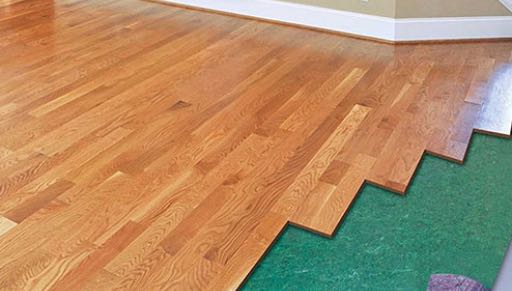Shop Underlayment
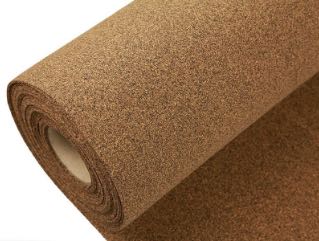
All Underlayment
- Thermal insulation
- Sound absorption
- Added durability
Shop All Underlayment
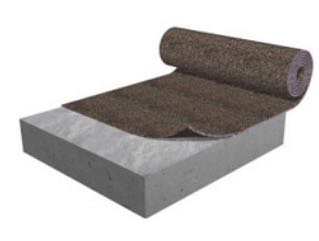
Rubber
- Great with stone, wood, and garage tiles
- For commercial and residential use
- Reduces noise and increases comfort
Shop All Rubber Underlayment
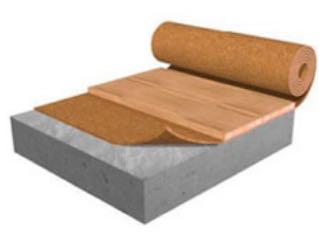
Cork
- Great with tile, hardwoods, and laminate
- Helps to keep cold floors warm
- Eco-friendly underlayment
Shop All Cork Underlayment
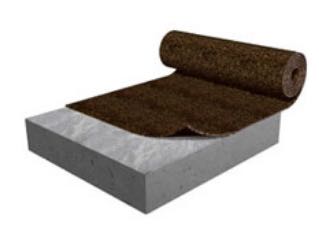
Rubber Cork
- Designed for crack suppression for tile & wood
- Offers sound reduction
- Mold- and mildew-resistant
Shop All Rubber Cork Underlayment
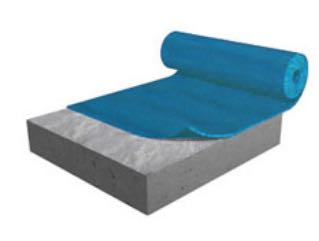
Foam
- Great for floating vinyl, laminate, and wood
- Provides insulation
- Reduces “hollow” sounds
Shop All Foam Underlayment
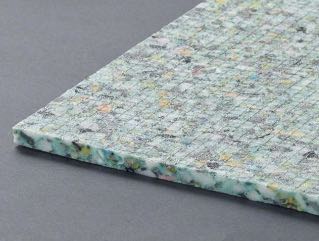
Carpet Padding
- Comfortable cushion for broadloom carpets
- Thermal insulation
- Boosts the durability of carpet
Shop All Carpet Padding
Underlayment by Flooring Type
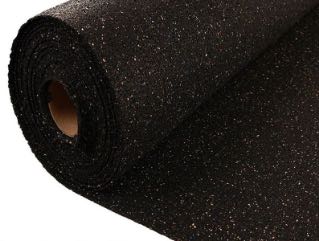
For Garage Tiles
Recommended: RubberShop Garage Tile Underlayment
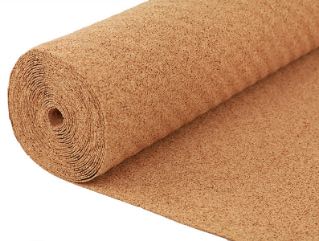
For Vinyl Flooring
Recommended: CorkShop Vinyl Flooring Underlayment
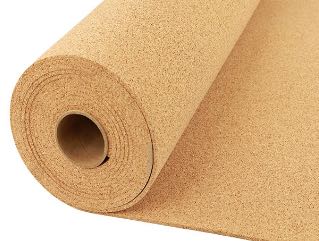
For Wood Flooring
Recommended: CorkShop Wood Flooring Underlayment
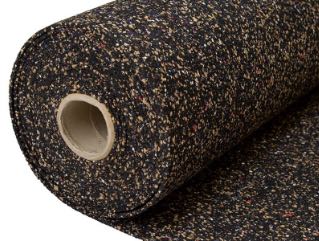
For Tile and Stone
Recommended: Rubber CorkShop For Tile and Stone
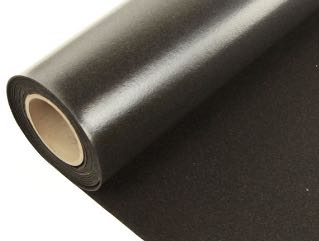
For Laminate
Recommended: FoamShop Laminate Underlayment
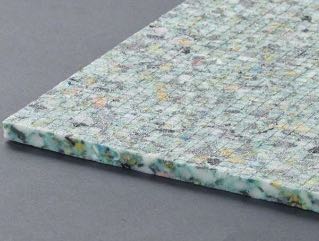
For Broadloom Carpet
Recommended: Carpet PadShop Carpet Padding
Customer Favorite Underlayment
Underlayment Reviews
Underlayment FAQs
Underlayment Overview
Underlayments are one of the key pieces to making a floor great. They add comfort and warmth under your flooring while reducing the hollow sounds that can come from floating floors. Underlayments are offered in many different materials including rubber, cork, rubber cork, and foam.
An underlayment’s main job is to insulate against sound, but there are other benefits that it offers in addition to that. It provides thermal insulation during the cold months, and some materials are better at that than others. Plus, some underlayments even increase the durability of your flooring by preventing cracks or keeping it from wearing down too quickly.
An underlayment’s main job is to insulate against sound, but there are other benefits that it offers in addition to that. It provides thermal insulation during the cold months, and some materials are better at that than others. Plus, some underlayments even increase the durability of your flooring by preventing cracks or keeping it from wearing down too quickly.
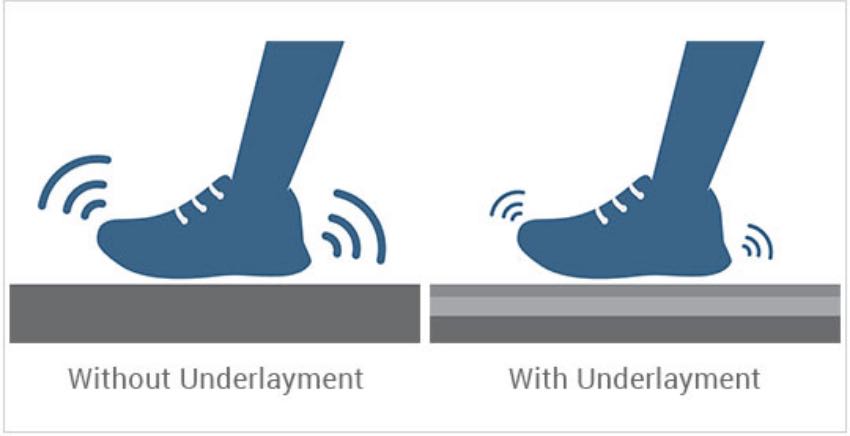
Why Do I Need Underlayments?
Underlayment is an amazing invention created out of necessity. It boasts an impressive list of benefits, including adding warmth to your floors so your feet aren’t so cold on new tile flooring, adding comfort and a slight ‘give’ underneath wood or vinyl floors, and reduced sound transmission (great for noisy houses), as well as reducing in-room noise.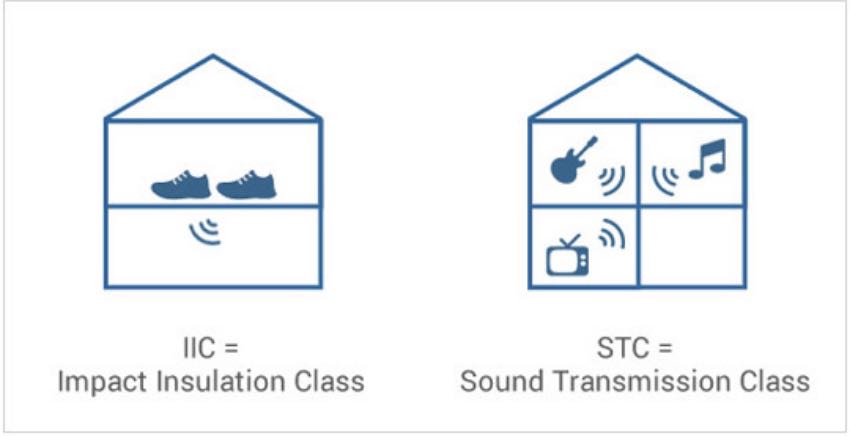
IIC and STC Ratings
Underlayment has two main rating systems to evaluate its performance. First, there is the IIC rating. IIC stands for Impact Insulation Class, which refers to impact sounds such as shoes hitting the ground, dropping a cell phone, or other scenarios where something is dropped or impacts the floor.STC stands for Sound Transmission Class, which refers to any audible noise (not an impact) such as music playing, a conversation, or a loud television. With both of these rating systems, the higher the number rating is for the underlayment, the better it will suppress sound, and the quieter a room will be. You may want to pay close attention to these ratings when shopping for underlayment if sound reduction is important to you.
Below you will find the estimated sound control for each underlayment material. Rubber tends to have the best sound control, while foam and felt won’t absorb as much sound.
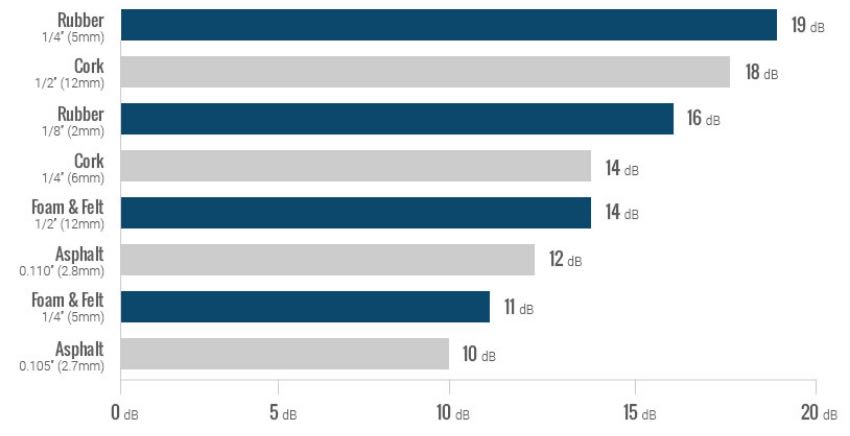
Underlayment Options
Rolls:
Rolls are the most traditional form of underlayment and are available in rubber, cork, foam, and rubber cork. To install, you just have to spread out the rolls one by one and align them along the edges, securing them to the subfloor if necessary or desired.Shop Rolls
Tiles:
Underlayment tiles are pretty unique. These tiles are incredibly easy to install since they interlock together like pieces of a puzzle.Shop Tiles
Sheets:
Sheets are typically made from cork or foam. They’re easier to install than rolls, because you can lay them out with minimal cutting, and you don’t have to maneuver a bulky roll.Shop Sheets
Types of Underlayment
| Options with Vapor Barrier | Safe with Vinyl | Installation | Crack Suppression | Compatible Flooring | |
|---|---|---|---|---|---|
| Rubber | No | No | Floated or adhered to the subfloor | Yes | Carpet, Hard Plastic Tiles, Hardwood |
| Cork | Yes | Yes | Adhered to subfloor | Yes | Laminate, Vinyl, Engineered Wood, Hardwood, Cork |
| Rubber Cork | No | No | Floated or adhered to the subfloor | Yes | Tile, Hardwood |
| Foam | Yes | Yes | Floated or adhered to the subfloor | No | Laminate, Vinyl, Engineered Wood, Hardwood, Carpet |
Rubber Underlayment
Rubber underlayment offers great sound absorption and durability while being made out of recycled materials. It is one of the best underlays for many flooring types, including stone, hardwoods, and garage tiles. However, it should not be used with vinyl or linoleum.
Rubber can be installed in areas where water may be an issue and is great over wood and concrete subfloors. When installing rubber underlay, it is recommended that it be loose laid, but you can also install it with double-sided tape, glue, nails, or staples. Rubber underlay is mold- and mildew-resistant as well.
Rubber can be installed in areas where water may be an issue and is great over wood and concrete subfloors. When installing rubber underlay, it is recommended that it be loose laid, but you can also install it with double-sided tape, glue, nails, or staples. Rubber underlay is mold- and mildew-resistant as well.
Pros:
- Offers great sound resistance.
- Very versatile and resilient.
- Is the favorite to use under hardwoods and stone.
- 2mm rubber underlayment is similar in sound resistance to 6mm cork underlayment.
- Is best to use where water may be present.
- Does not have to be adhered with adhesive.
Cons:
- Can be more expensive.
- Can stain vinyl and linoleum flooring.
Shop our most popular rubber underlayment options:
| Standard Thickness | IIC | STC | |
|---|---|---|---|
| 2mm Pre-Cut Rubber Underlayment | 2mm | 60 | 54 |
| 5mm Pre-Cut Rubber Underlayment | 5mm | 60 | 53 |
| 6mm Pre-Cut Rubber Underlayment | 6mm | 60 | 55 |
Cork Underlayment
Cork underlayment is cost-effective, eco-friendly, and offers great sound absorption as well as durability. The natural thermal properties of cork help to keep your floor warmer and your feet more comfortable.
Cork underlay is the most popular underlayment used in condos, apartments, and other high rise buildings. This is because cork is great at inhibiting sound from floor to floor and it can be installed under any flooring type. Cork underlayment is typically adhered to the subfloor but can be installed with double-sided tape or floated. We do not recommend putting nails or staples through the underlay since that will diminish the cork’s acoustical value.
Cork is naturally resistant to mold, mildew, and water. However, on ground floors or in basements, it is recommended that the cork be installed with a vapor barrier underneath. This is due to moisture being able to flow through the cork underlay which can damage your beautiful new flooring.
Cork underlay is the most popular underlayment used in condos, apartments, and other high rise buildings. This is because cork is great at inhibiting sound from floor to floor and it can be installed under any flooring type. Cork underlayment is typically adhered to the subfloor but can be installed with double-sided tape or floated. We do not recommend putting nails or staples through the underlay since that will diminish the cork’s acoustical value.
Cork is naturally resistant to mold, mildew, and water. However, on ground floors or in basements, it is recommended that the cork be installed with a vapor barrier underneath. This is due to moisture being able to flow through the cork underlay which can damage your beautiful new flooring.
Pros:
- Cost-effective and eco-friendly.
- Great for use with all flooring types.
- Thermal properties keep your floor warmer.
- Is mold and mildew resistant.
- Will expand and contract with your flooring.
- Allows air to flow freely through the flooring system.
Cons:
- Not recommended in areas where water may be present.
- Needs a vapor barrier.
- Requires a polyurethane adhesive.
Shop our most popular cork underlayment options:
| Standard Thickness | IIC | STC | |
|---|---|---|---|
| AcoustiCORK Quiet Comfort w/Vapor Barrier | 2.5mm | 67 | 72 |
| Eco-Cork Roll | 3mm | Not Tested | Not Tested |
| R60 | 6mm | 63 | 60 |
Rubber Cork Underlayment
Rubber cork is a combination underlayment that is specifically designed for crack suppression with superior comfort in mind. This underlayment can be installed under most flooring types, but it is ideal for use underneath hardwood and tile floors.
Rubber cork underlayment is great for crack suppression. Have you ever installed a tile floor on the first level or in a basement and then, after a year, you start noticing cracks appearing in your floor? This is due to your foundation settling. Homes are meant to move, but this movement can spell trouble for your floor.
This is where rubber cork underlay comes to the rescue. It will help to prevent the subfloor cracks from affecting your floor. Rubber cork underlayment can be installed under most flooring types, but it’s great under hardwood and tile floors. These rolls are mold and mildew resistant and feature the same thermal properties that cork has. Rubber Cork rolls are typically installed loose laid but can be installed with double-sided tape or adhesive.
Rubber cork underlayment is great for crack suppression. Have you ever installed a tile floor on the first level or in a basement and then, after a year, you start noticing cracks appearing in your floor? This is due to your foundation settling. Homes are meant to move, but this movement can spell trouble for your floor.
This is where rubber cork underlay comes to the rescue. It will help to prevent the subfloor cracks from affecting your floor. Rubber cork underlayment can be installed under most flooring types, but it’s great under hardwood and tile floors. These rolls are mold and mildew resistant and feature the same thermal properties that cork has. Rubber Cork rolls are typically installed loose laid but can be installed with double-sided tape or adhesive.
Pros:
- Specifically made for crack suppression.
- Is mold- and mildew-resistant.
- Does not have to be adhered with adhesive.
- Will expand and contract with your flooring surface.
- Provides added comfort to your flooring.
Cons:
- Can stain vinyl and linoleum.
- A vapor barrier is recommended.
Shop our most popular rubber cork underlayment options:
| Standard Thickness | IIC | STC | |
|---|---|---|---|
| AcoustiCORK R12 Underlayment | 1.2mm | 40 | 52 |
| AcoustiCORK RC500 Underlayment | 5mm | 50 | 50 |
| 9.5mm AcoustiCORK CRC950 Sheets | 9.5mm | 52 | 56 |
Foam Underlayment
Foam underlayments are an affordable underlayment option for use with most flooring types, including carpet, laminate, and vinyl. It offers some sound resistance and adds durable resiliency to the floor.
Foam underlay is popular because it’s affordable but still provides excellent sound reduction properties. Foam is very easy to install, and many options have an attached vapor barrier to protect both the floor and underlay from moisture. Some foam underlays come with attached adhesive strips which makes installation even easier, while others have to be glued, nailed, stapled or taped. Foam is mold- and mildew-resistant and has thermal properties.
Foam underlay is popular because it’s affordable but still provides excellent sound reduction properties. Foam is very easy to install, and many options have an attached vapor barrier to protect both the floor and underlay from moisture. Some foam underlays come with attached adhesive strips which makes installation even easier, while others have to be glued, nailed, stapled or taped. Foam is mold- and mildew-resistant and has thermal properties.
Pros:
- Can be used under any floor.
- Inexpensive underlay option.
- Excellent moisture protection.
- Mold and mildew resistant.
- Is favorite under floating floors and carpet.
- Reduces sound under laminates and hardwood floors.
- Easy to install.
Cons:
- May not provide ideal sound resistance.
- May allow telegraphing of subfloor.
Shop our most popular foam underlayment options:
| Standard Thickness | IIC | STC | |
|---|---|---|---|
| Combo Foam Underlayment | 2mm | 51 | 52 |
| Silent Silver 3-in-1 | 3mm | 72 | 73 |
| EZ-Floor Foam Underlayment | 7/16” | 69 | 66 |
Carpet Padding
Carpet pads are made of felt or foam, but they’re different from standard foam underlayments. They don’t have IIC and STC ratings. Instead, the focus is more on the comfort of the padding, and any added features it may come with. For example, some carpet pads will have moisture barriers to prevent damage from spills, or an insulation rating, or are treated to resist mold and mildew.
Additionally, many carpet pads are made from recycled foam, making this an eco-friendly addition to your home. This way, you can get added comfort, thermal insulation, and even some sound insulation while still benefiting the planet.
Additionally, many carpet pads are made from recycled foam, making this an eco-friendly addition to your home. This way, you can get added comfort, thermal insulation, and even some sound insulation while still benefiting the planet.
Pros:
- Adds softness under the carpet.
- Eco-friendly options.
- Provides thermal insulation.
- Can feature a moisture barrier.
- Options for mold and mildew resistance.
Cons:
- No IIC or STC rating.
- Non-treated padding can absorb moisture.
Shop our most popular carpet padding options:
| Standard Thickness | Insulation Rating | Moisture Barrier | |
|---|---|---|---|
| Courage Carpet Pad | 1/2" | R 2.2 | Yes |
| Ruby Carpet Pad | 7/16" | R 1.6 | No |
| Charity Carpet Pad | 1/2" | R 1.8 | Yes |
Residential vs. Commercial Underlayment
Residential
All underlayment is suitable for home use, but some options will work better to make your space feel cozy. For thick, plush carpets, you’ll want some foam underlayment to add even more softness. If you have wood or wood-look plank flooring, cork or foam is your best bet for a solid surface with some springiness underfoot. Rubber underlayments are perfect for use in the garage or outdoors.Shop Residential Underlayment
Commercial
Commercial flooring needs to be tough, so it needs a strong, durable underlayment to support it. Typically, rubber is the go-to option for businesses and public spaces. It reduces the likelihood of the floor cracking or fracturing, and it’s mold- and mildew-resistant as well.Shop Commercial Underlayment


